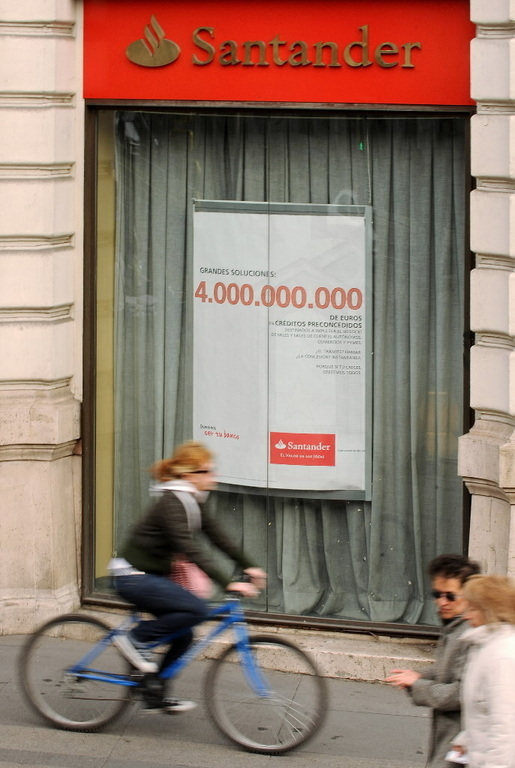
MADRID – Anyone wondering why the most profitable bank in the euro region pays more to borrow than some of the worst performers can find the answer in Spain, where high unemployment and a sputtering economy pushed up funding costs at Banco Santander SA.
Santander, the parent company of Sovereign Bancorp, sold 1 billion euros ($1.4 billion) of 4.125 percent, seven-year senior bonds last month with a AA rating that yield 156 basis points more than average market rates. Germany’s Commerzbank AG, which required a government rescue in 2008, issued 1 billion euros of 4 percent, 10-year senior debt with an A rating that yields 126 basis points more than the benchmark.
Bondholders are penalizing Santander, based in the northern Spanish city of the same name, because the nation’s jobless rate — at 20.5 percent in August — was the highest in the euro region and the budget deficit was the third biggest last year as a proportion of gross domestic product. Moody’s Investors Service cut Spain’s debt rating in September because of doubts about the country’s ability to generate enough growth to meet its fiscal targets beyond 2011.
“If Santander were a bank in Germany or France, it would be best in class,” said Inigo Lecubarri, who manages about $200 million at Abaco Financials Fund in London. “The problem they have is that their address is Spanish.”
Santander Chairman Emilio Botin spent more than $60 billion on acquisitions during the past decade to gain market share in countries ranging from Brazil to Britain. The takeovers helped Santander earn 26.9 billion euros in the three years through 2009, the most among banks in the 16 nations sharing the euro.
Commerzbank Scorecard
Commerzbank, Germany’s second-largest bank, reported a loss of 4.54 billion euros last year, after earning 3 million euros in 2008 and 1.92 billion euros the previous year. The company tapped the government for 18.2 billion euros of aid during the credit crunch, leaving the state with a 25 percent stake.
Commerzbank dropped 63 percent in Frankfurt trading since U.S. investment bank Lehman Brothers Holdings Inc. went bankrupt in September 2008, while Santander fell just 9 percent. Today, Santander ranks as the biggest bank in continental Europe, with a market value of 79 billion euros.
Santander, which has a AA credit rating after remaining profitable every quarter through the financial crisis, also pays more to borrow than lower-rated German rival Deutsche Bank AG. The 1.15 billion euros of 10-year, 5 percent subordinated debt that Frankfurt-based Deutsche Bank sold in June with an A rating yields 138 basis points more than the so-called mid-swap rate.
Spain ‘Stigma’
Higher borrowing costs will hurt Santander’s profit margins, said John Raymond, an analyst at CreditSights Inc. in London. Third-quarter earnings at Banco Espanol de Credito SA, Santander’s consumer-banking unit in Spain, fell 52 percent as lending revenue declined and costs for bad loans increased.
“Even if they aren’t trying to raise funds, it’s a problem because investors are going to use their cost of funds as a way to measure how risky they are,” Raymond said. “It’s a kind of stigma.”
Spain now accounts for about 22 percent of Santander’s profit, down from 36 percent at the end of 2004. The decrease occurred with the acquisitions, including the 12.5 billion-euro purchase of Abbey National Plc in the U.K. and the 11 billion- euro takeover of ABN Amro Holdings NV’s Brazilian unit.
After the deals, about 75 percent of the bank’s wholesale funding is still done in euros.
Officials at Santander declined to comment.
Peripheral Spreads
Investors demand a fatter yield to buy Santander’s debt because of concern that Spain, along with other euro peripherals Greece, Portugal and Ireland, will struggle to revive economic growth and pare their budget deficits at the same time.
Santander’s 3.5 percent bonds maturing in 2015 yield 121 basis points more than the mid-swap rate, according to data compiled by Bloomberg. By comparison, BNP Paribas SA, France’s biggest bank, sold 1.5 billion euros of senior five-year bonds that yield 48 basis points over mid swaps. A basis point is equivalent to 0.01 percentage point.
BNP Paribas has the same credit rating at Standard & Poor’s as Santander.
Deutsche Bank has an A+ rating and stable outlook from S&P, two levels lower than Santander. S&P has maintained a negative outlook on the Spanish bank since March 2009.
Moody’s cut Spain’s debt rating last month by one level to Aa1 from Aaa. Germany and France still carry Moody’s highest rating.
IMF’s View
The International Monetary Fund estimates Spain’s economy will grow 0.7 percent next year, compared with the government’s 1.3 percent forecast. The nation’s gross domestic product will shrink by about 0.3 percent this year after contracting 3.7 percent in 2009.
Santander has about 68 billion euros of debt that matures from now through the end of 2012, according to Bloomberg data. Banco Bilbao Vizcaya Argentaria SA, Spain’s second-biggest bank, has 30 billion euros of debt coming due in the same period. Bilbao-based BBVA relies on Spain for about half of its profit.
Santander is perceived as more risky than some competitors in the credit-default swaps market. The cost of insuring the Spanish bank’s debt for five years was about 143 basis points yesterday, compared with 84 basis points for Deutsche Bank and 80 basis points for BNP Paribas, according to CMA prices.
“We have had Greece and Ireland, and now the market is looking for the next whipping boy,” said John Anderson, who helps oversee about 23 billion pounds ($36 billion) as head of credit at London-based Gartmore Investment Management Ltd., referring to Santander and BBVA. “I don’t necessarily agree that the market has got it right.”
Competing for Deposits
Spanish banks have been forced to compete for customer funds to close the gap between loans and deposits, which made lenders vulnerable when wholesale financing costs climbed, said Claire Kane, an analyst at MF Global in London. Santander raised 30 billion euros this year in Spain from a deposit-gathering campaign by offering customers a 4 percent interest rate. The average three-month interbank rate is 0.75 percent.
Borrowing costs have retreated in Spain since July, as investors digested government commitments to cut the deficit and the results of stress tests coordinated by the Committee of European Banking Supervisors. Santander’s Tier 1 capital ratio, a measure of solvency, would stay at 10 percent, the same level as at the end of 2009, under the most severe stress test scenario, the Bank of Spain said on July 23.
The extra yield that investors demand to hold 10-year Spanish debt rather than German bunds was 174 basis points yesterday, down from a high of 221 basis points on June 16.
Unless investor perceptions about the outlook for Spanish growth and the government’s ability to cut its budget deficit in half by next year keep improving, Santander will remain hostage to higher funding costs, said Lecubarri of Abaco Financials.
“If Santander could walk away from Spain and base itself in Zurich, that would be great, but that’s not going to happen,” he said. “They can’t just detach themselves.”












